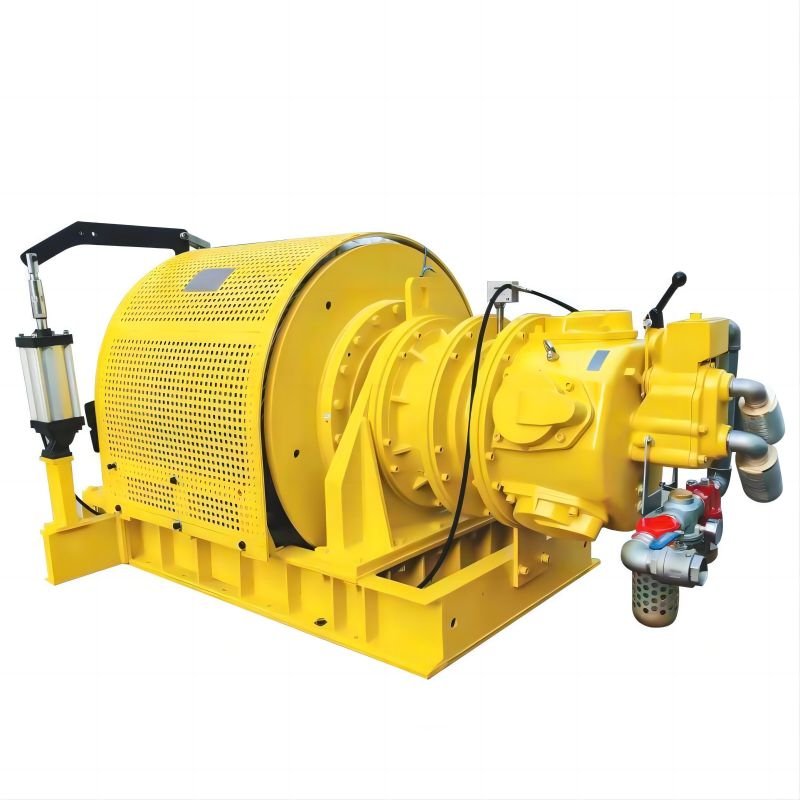Les treuils pneumatiques sont des dispositifs essentiels utilisés dans diverses applications industrielles, offrant des capacités de levage et de traction fiables et puissantes. Comprendre leur fonctionnement est essentiel pour les industries qui dépendent de machines lourdes. Dans cet article complet, nous nous plongeons dans les subtilités des treuils pneumatiques, en explorant leurs composants, leurs fonctionnalités et leurs avantages.

Introduction aux treuils pneumatiques
UN treuil pneumatique utilise l'air comprimé comme principale source d'énergie pour fonctionner. Cela le rend idéal pour les environnements où les treuils électriques peuvent présenter un danger ou être moins efficaces. Les treuils pneumatiques sont couramment utilisés dans les secteurs tels que le pétrole et le gaz, l'exploitation minière et les opérations maritimes.
Composants clés d'un treuil pneumatique
1. Moteur pneumatique
Le moteur pneumatique est le cœur du treuil pneumatique. Il convertit l'air comprimé en énergie mécanique, entraînant ainsi le tambour du treuil. Ce composant est connu pour sa durabilité et sa capacité à fonctionner dans des conditions extrêmes.
2. Tambour de treuil
Le tambour du treuil est l'endroit où le câble ou la corde est enroulé. Il tourne sous l'action du moteur pneumatique, ce qui permet au treuil de tirer ou de soulever de lourdes charges.
3. Système de contrôle
Le système de contrôle comprend des vannes et des leviers qui régulent le débit d'air comprimé, contrôlant ainsi la vitesse et la direction du treuil. Ce système garantit une manutention précise des charges.
4. Système de freinage
Un système de freinage fiable est essentiel pour la sécurité. Les treuils pneumatiques sont généralement équipés d'un frein automatique qui s'enclenche lorsque l'alimentation en air est coupée, empêchant ainsi toute chute accidentelle de la charge.
5. Boîte de vitesses
La boîte de vitesses ajuste la vitesse et le couple du treuil, le rendant polyvalent pour diverses tâches de levage et de traction.
Comment fonctionne un treuil pneumatique
1. Alimentation en air comprimé
L'opération commence par une alimentation en air comprimé, généralement assurée par un compresseur d'air. L'air comprimé est canalisé par des tuyaux jusqu'au treuil.
2. Activation du moteur pneumatique
Lorsque le levier de commande est engagé, l'air comprimé pénètre dans le moteur pneumatique. Les palettes ou pistons internes du moteur convertissent cette pression d'air en mouvement de rotation.
3. Rotation du tambour
L'énergie de rotation du moteur pneumatique est transmise au tambour du treuil via le réducteur. Lorsque le tambour tourne, le câble ou la corde attachée s'enroule ou se déroule, ce qui permet au treuil de soulever ou de tirer des charges.
4. Manutention de la charge
L'opérateur peut contrôler la vitesse et la direction du tambour grâce au système de commande, ce qui garantit une manutention fluide et précise de la charge. Le système de freinage s'enclenche automatiquement lorsque le levier de commande est relâché, ce qui permet de maintenir la charge en place.
Avantages des treuils pneumatiques
1. Sécurité dans les environnements dangereux
Les treuils pneumatiques ne nécessitant pas d'électricité, ils peuvent être utilisés en toute sécurité dans des environnements explosifs ou inflammables. Il s'agit d'un avantage considérable dans des secteurs tels que le pétrole et le gaz.
2. Durabilité et fiabilité
Les treuils pneumatiques sont conçus pour résister aux conditions difficiles, notamment aux températures extrêmes et aux environnements humides. Leur construction robuste garantit une fiabilité à long terme.
3. Fonctionnement continu
Contrairement aux treuils électriques, les treuils pneumatiques peuvent fonctionner en continu sans risque de surchauffe. Ils sont donc idéaux pour les tâches industrielles exigeantes.
4. Couple de sortie élevé
Les treuils pneumatiques offrent un couple élevé, ce qui leur permet de manipuler facilement des charges lourdes. Cela est particulièrement avantageux dans les applications nécessitant une puissance de levage importante.
Applications des treuils pneumatiques
1. Industrie pétrolière et gazière
Les treuils pneumatiques sont largement utilisés dans les opérations de forage, où ils manipulent des équipements et des matériaux lourds. Leurs caractéristiques de sécurité les rendent adaptés aux plateformes offshore.
2. Opérations minières
Dans le secteur minier, les treuils pneumatiques sont utilisés pour transporter du minerai et d'autres charges lourdes. Leur capacité à fonctionner dans des environnements poussiéreux et explosifs constitue un avantage clé.
3. Industrie maritime
Les applications marines impliquent souvent des environnements difficiles et corrosifs. Les treuils pneumatiques sont privilégiés pour des tâches telles que la manutention des ancres et le chargement de marchandises en raison de leur résilience et de leurs performances.
Conseils d'entretien pour les treuils pneumatiques
1. Inspection régulière
Des inspections fréquentes garantissent que tous les composants sont en bon état de fonctionnement. Recherchez des signes d'usure, en particulier au niveau du moteur pneumatique et du système de freinage.
2. Lubrification
Une lubrification adéquate du moteur pneumatique et des autres pièces mobiles est essentielle pour éviter les frottements et l'usure. Utilisez les lubrifiants recommandés pour des performances optimales.
3. Qualité de l'alimentation en air
Assurez-vous que l'air comprimé est propre et sec. Les impuretés présentes dans l'alimentation en air peuvent endommager le moteur pneumatique et d'autres composants.
4. Remplacez les pièces usées
Le remplacement rapide des pièces usées comme les câbles, les freins et les joints contribue à maintenir l'efficacité et la sécurité du treuil.
Conclusion
Les treuils pneumatiques sont la pierre angulaire des opérations industrielles lourdes, offrant une sécurité, une durabilité et une efficacité inégalées. Leur capacité à fonctionner dans des environnements dangereux les rend indispensables dans des secteurs tels que le pétrole et le gaz, l'exploitation minière et les opérations maritimes. En comprenant le fonctionnement de ces treuils et en les entretenant correctement, les entreprises peuvent garantir un fonctionnement fluide et fiable, maximisant ainsi leur investissement.
Pour plus de détails sur nos treuils pneumatiques, visitez Treuils pneumatiques KRC